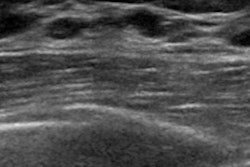
Automated breast ultrasound (ABUS) can yield lower recall rates than handheld ultrasound, but unnecessary recalls still occur -- and it's important to find ways to reduce them, according to research presented at the recent American Institute of Ultrasound in Medicine (AIUM) annual meeting in New York City.
Why? Because having fewer recalls leads to fewer unnecessary biopsies and also less-stressed patients, lead researcher Dr. Beverly Hashimoto of Virginia Mason Medical Center in Seattle told AuntMinnie.com via email.
 Dr. Beverly Hashimoto of Virginia Mason Medical Center.
Dr. Beverly Hashimoto of Virginia Mason Medical Center."One of the weaknesses of screening breast ultrasound is that it results in a high number of women being called back for additional imaging," Hashimoto said. "When we started our automated breast ultrasound program, we wanted to determine if there were lessons we could learn from reviewing our ultrasound callbacks to reduce the number of patients recalled in the future."
Reducing recalls
ABUS offers benefits over handheld ultrasound for breast cancer screening, in part because it reduces the modality's dependency on operator skill. But the technology doesn't completely eliminate screening downsides such as unnecessary recalls, study presenter Elissa Picozzi from the University of Washington told session attendees.
She and her colleagues examined 18 months of their experience with screening ABUS. All patients included in the study were asymptomatic and had heterogeneous or extremely dense breast tissue. The researchers focused their attention on patients who were called back for additional imaging due to a category 0 ABUS screening assessment ("incomplete").
 Elissa Picozzi from the University of Washington.
Elissa Picozzi from the University of Washington.At Virginia Mason, patients called back for a possible ABUS abnormality undergo a diagnostic handheld ultrasound exam; if this exam is a category 4 or 5 (suspicious or highly suspicious of malignancy), then the woman has an ultrasound-guided core biopsy. The researchers reviewed ABUS images, handheld ultrasound images, and any pathology results from biopsy.
In that first year and a half of the medical center's screening ABUS practice, 867 exams were performed. Of these, 229 patients (26%) were called back for a possible ABUS lesion and had a diagnostic handheld ultrasound exam; 69 (8%) had biopsies.
Of the 229 patients called back, 222 were recalled for category 2 or 3 lesions. Results from the handheld ultrasound exams in these 222 patients were as follows:
- 68 patients (30.6%) with solid hypoechoic masses
- 71 patients (32%) with no abnormality -- the "lesions" on ABUS were actually artifact shadowing
- 35 patients (15.8%) with nonsimple cysts
- 20 patients (9%) with simple cysts
- 28 patients (12.6%) with miscellaneous lesions, including duct ectasia, scars, fat lobules, fat necrosis, or lymph nodes
The 69 biopsies revealed seven malignancies; of these, four were found only on ABUS. The cancer detection rate for ABUS was 4.6 per 1,000 cases.
Better evaluation?
Hashimoto and colleagues found that image artifacts masquerading as lesions were a frequent cause of unnecessary recalls. Many of these recalls could be avoided by using alternative reconstruction techniques and more careful consideration of different ABUS views, they noted.
"We were surprised to find that the second most common reason for calling a patient back was artifactual ultrasound shadowing," she told AuntMinnie.com. "As a result, we have developed techniques to better analyze shadowing on screening ultrasounds. We also discovered that many of the solid masses that were called back could have been resolved by changing our reviewing process of prior exams."




















